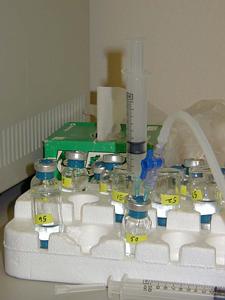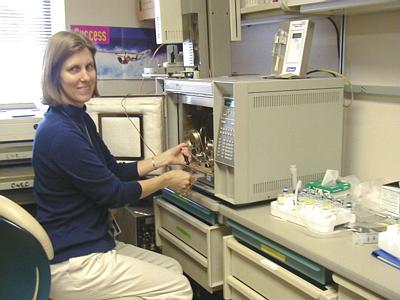18 November, 1999
McMurdo Station, Antarctica Thursday
*****If photo's had not arrived with yesterday's journal (11/17/99), please
go back and check them out. The Dry Valleys are spectacular!
Today we had our first analytical day. Into evacuated vials(that means that
there is a vacuum in the vials) Julie and Bess injected gas from the silver
sample bags. We were hoping to see the presence of nitrous oxide. This gas
would indicate that the process of denitrification is occurring.
Denitrification puts nitrogen back into the atmosphere. Our atmosphere is
about 79% nitrogen, so this gas is important. Other bacteria take nitrogen
gas from the atmosphere and use it for metabolism making ammonia and
nitrate.
I took the vials into the Analytical Lab for analysis on the gas
chromatograph (GC). The GC measures a variety of gaseous compounds. Each GC
is fitted with a parcticular detector that is capable of recognizing specific
compounds. Our detector will identify hydrogen, carbon dioxide, nitrous
oxide, and acetylene (this is added to the sample bags to stop the
denitrification process at the nitrous oxide stage). The GC will also
quantitate the gases. That is, it can determine not only what gases are
present, but also how much of the gas is present.
The gas sample is injected, by a gas-tight syringe, into the injection port
of the GC. We have installed into our GC a loop that measures exactly 1 mL
of sample. The sample moves through these loops, called columns, eventually
making it to the detector. Our detector is called an electron capture
device (ECD). The ECD sends a signal to a computer and the computer draws a
graph showing us the gases present and the concentration of each gas. Each
"shot" on the GC takes about 10 minutes. We are running 88 shots each day.
How long will it take us to complete our day's work? A very long time and
that's assuming that everything is working properly!
We were pleased to see that nitrous oxide WAS present in our samples that we
collected from West Lake Bonney! This tells us that denitrification was
probably occurring in the west lobe of the lake. The real mystery will
happen when we begin to process samples from the east lobe. Though the same
bacteria are present, previous data suggested that denitrification doesn't
occur here. The group is going out tomorrow to collect from the east lobe.
I'll stay back to run the GC.
A quick note to tell you how small the world really is! Earlier this week a
dear friend of mine, Dr. Mike Madigan, arrived at McMurdo for his first trip
to the continent! Mike was the first person to ever give me a job as a
professional! This was in 1981! He and his wife Nancy have been friends
with me ever since! Mike will be the subject of a Polar Profile later this
month! Welcome Mike to McMurdo and the great continent of Antarctica! It's
good to see you again!
Answer to yesterday's question: Robert F. Scott discovered the first of the
Dry Valleys in 1903 and named it Taylor Valley after a famous geologist.
Scott wrote "I cannot but think that this valley is a very wonderful place.
We have seen today all the indications of colossal ice action and
considerable water action, and yet neither of these agents is now at
work...it is certainly a valley of the dead; even the great glacier which
once pushed through it has withered away." Scott was mistaken when he
called the Dry Valleys "dead". We now know that life can be found in the
most fragile of places!
Today's question: We are interested in the process of denitrification. We
are measuring the presence of nitrous oxide, an intermediate step in the
process. Why can't we measure the production of nitrogen?
Polar Profile: This feature will return on Friday.
Sharon
JUST FOR KIDS!!!!! Today we had our first analytical day! We finally had
samples that we could test! I worked on an instrument called a gas
chromatograph (GC). The GC has loops of tubing called columns. The gases
from our samples pass through these loops. When they reach a parcticular
place, the gas is identified by the GC and the amount of the gas is
determined. A computer 'reads' this information and draws a graph. Our GC
can measure oxygen, carbon dioxide, nitrous oxide, and acetlyene.
We are parcticularly interested in nitrous oxide. If this gas is present,
then our bacteria are denitrifying. That is a big word! A bacteria that
denitrifies, sends nitrogen gas back into our atmosphere. Did you know that
our atmosphere, the air that you breathe, is mostly nitrogen? Does that
surprise you? These bacteria are important because they return the
nitrogen to the air. In our first samples, we found nitrous oxide! We were
very excited!
Answer to yesterday's question: Robert F. Scott discovered the first of the
Dry Valleys in 1903 and named it Taylor Valley after a famous geologist.
Scott wrote "I cannot but think that this valley is a very wonderful place.
We have seen today all the indications of colossal ice action and
considerable water action, and yet neither of these agents is now at
work...it is certainly a valley of the dead; even the great glacier which
once pushed through it has withered away." Scott was mistaken when he
called the Dry Valleys "dead". We now know that life can be found in the
most fragile of places!
Today's question: We are interested in the process of denitrification. We
are measuring the presence of nitrous oxide, a middle step in the process.
Why can't we measure the production of nitrogen?
Polar Profile: This feature will return on Friday.
Sharon

This is the analytical instrument at which I will spend many hours! It is called a gas chromatograph.

Bess weighs one of our sampling bags.

This is how we fill the syringe with the gas from our sample vial. The attachment on the right side of the vial is delivering saturated potassium chloride (KCl). This ensures that the contents of the vial remain at atmospheric pressure. The concentration of the nitrous oxide could be affected by a change in pressure.

Julie is preparing a sample for "shooting" into the GC.

Sharon injects the sample into the GC injection port.

The guts of the gas chromatograph. The small coil on the left measures 1 mL samples. The coil on the right measures 5 mL samples. The large coil in the center delivers the sample to the detector. The injection ports are on the lower right and are labeled "1 mL" and "5 mL".

Dr. Michael Madigan from Southern Illinois University. Mike was the first person to employ me as a microbiologist in 1981!
Contact the TEA in the field at
.
If you cannot connect through your browser, copy the
TEA's e-mail address in the "To:" line of
your favorite e-mail package.
|
